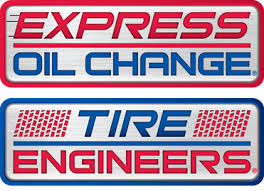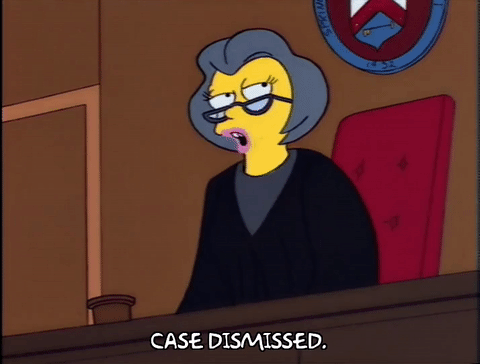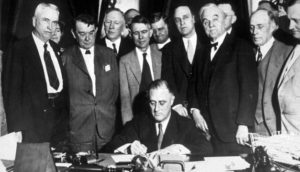 Fed. R. Civ. P. 8(c) requires parties to “affirmatively state any avoidance or affirmative defense.” Germain v. U.S. Bank applied that rule in a mortgage-servicing case, reasoning: “Germain alleged that the Defendants did not comply with § 1024.41. The Defendants denied this allegation, insisting that they had complied with that section. That is a denial or direct contradiction of Germain’s claim, not an affirmative defense. The Defendants did not expressly rely on § 1024.41(i) in their answer, but the use of § 1024.41(i) in their motion for summary judgment is merely an expansion of the denial in their answer.” No. 18-10508 (April 3, 2019). (“8c” also refers to an Alfa Romeo model, pictured above for general reference.)
Fed. R. Civ. P. 8(c) requires parties to “affirmatively state any avoidance or affirmative defense.” Germain v. U.S. Bank applied that rule in a mortgage-servicing case, reasoning: “Germain alleged that the Defendants did not comply with § 1024.41. The Defendants denied this allegation, insisting that they had complied with that section. That is a denial or direct contradiction of Germain’s claim, not an affirmative defense. The Defendants did not expressly rely on § 1024.41(i) in their answer, but the use of § 1024.41(i) in their motion for summary judgment is merely an expansion of the denial in their answer.” No. 18-10508 (April 3, 2019). (“8c” also refers to an Alfa Romeo model, pictured above for general reference.)
 Beckton Dickson & Co., a manufacturer of safety syringes, lost its antitrust claims against a competitor but prevailed on its Lanham Act claims, and sought the remedy of disgorgement. A panel majority concluded that:
Beckton Dickson & Co., a manufacturer of safety syringes, lost its antitrust claims against a competitor but prevailed on its Lanham Act claims, and sought the remedy of disgorgement. A panel majority concluded that:
[T]he district court did not abuse its discretion in determining that where [Defendant Retractable Technologies, Inc.] had not sufficiently demonstrated that its business suffered due to BD’s false advertising and where BD had already taken significant steps to correct the false statements, disgorgement was not equitable. That another court could have evaluated the facts differently does not justify reversal, especially as “an award of profits with no proof of harm is an uncommon remedy in a false advertising suit.”
The majority’s reasoning is best summarized by the final paragraph of its opinion, which observes:
The district court’s denial of disgorgement of profits from RTI’s competitor was made against the larger backdrop of its prosecution of a meritless antitrust claim against BD for conduct in the marketplace—during a time in which RTI nearly doubled its own sales and increased its share of the retractable syringe sub-market to two-thirds. RTI elected not to test its proof of Lanham Act damages before the jury, but rather to later argue, as now, that equity mandates disgorgement. Its effort to carry the flag of “public interest” and guide the profits of its competitor to its own coffers here must fail. That effort must be taken outside—to the marketplace. There the public interest is best vindicated.
A dissent thought that the district court had exceeded its mandate after a previous appeal. Retractable Technologies, Inc. v. Beckton Dickinson Inc., No. 17-40960 (March 26, 2019). Professor Rebecca Tushnet recently discussed the case on her 43(B) blog.
 The Tampa Bay Buccaneers football team sought recovery in BP’s Deepwater Horizon claims-processing system. It appealed to the Fifth Circuit, and requested that the courtroom be sealed for the oral argument. In a single-judge order, Judge Costa reviewed the general requirements about sealing, noted that it was the court’s decision and not the litigants’, and rejected the request: “As its right, Claimant ID 100246928 has used the federal courts in its attempt to obtain millions of dollars it believes BP owes because of the oil spill. But it should not able to benefit from this public resource while treating it like a private tribunal when there is no good reason to do so. On Monday, the public will be able to access the courtroom it pays for.” BP Exploration & Production v. Claimant ID 100246928, No. 18-30375 (March 29, 2019).
The Tampa Bay Buccaneers football team sought recovery in BP’s Deepwater Horizon claims-processing system. It appealed to the Fifth Circuit, and requested that the courtroom be sealed for the oral argument. In a single-judge order, Judge Costa reviewed the general requirements about sealing, noted that it was the court’s decision and not the litigants’, and rejected the request: “As its right, Claimant ID 100246928 has used the federal courts in its attempt to obtain millions of dollars it believes BP owes because of the oil spill. But it should not able to benefit from this public resource while treating it like a private tribunal when there is no good reason to do so. On Monday, the public will be able to access the courtroom it pays for.” BP Exploration & Production v. Claimant ID 100246928, No. 18-30375 (March 29, 2019).
 Emphasizing a significant difference between Texas and federal practice, ENI US Operating Co. v. Transocean clarified Circuit precedent and held: “Under [Fed. R. Civ. P.] 52(a), implicit findings will not automatically be inferred to support a conclusory ultimate finding. The district court must lay out enough subsidiary findings to allow us to glean ‘a clear understanding of the analytical process by which [the] ultimate findings were reached and to assure us that the trial court took care in ascertaining the facts.” Finding that the district court’s reasoning was insufficiently developed under this standard, the Fifth Circuit remanded for more detailed findings on a key point. The Court also reversed on two other issues of
Emphasizing a significant difference between Texas and federal practice, ENI US Operating Co. v. Transocean clarified Circuit precedent and held: “Under [Fed. R. Civ. P.] 52(a), implicit findings will not automatically be inferred to support a conclusory ultimate finding. The district court must lay out enough subsidiary findings to allow us to glean ‘a clear understanding of the analytical process by which [the] ultimate findings were reached and to assure us that the trial court took care in ascertaining the facts.” Finding that the district court’s reasoning was insufficiently developed under this standard, the Fifth Circuit remanded for more detailed findings on a key point. The Court also reversed on two other issues of  contract law:
contract law:
- A clause referring to an indemnity obligation for “special, indirect, or consequential damages,” while a “limitation on the type of damages allowed . . . says nothing about what type of claims can be brought” (and thus, does not preclude a breach-of-warranty action); and
- A damages calculation based on a steady contract price was flawed because “it looks to what Eni actually did
 after termination, when the operative question is what Eni would have done in a non-breach world. . . . The district court should have attempted to determine, in the hypothetical non-breach world, how many days the Pathfinder [above, left] would have spent at each applicable rate.”
after termination, when the operative question is what Eni would have done in a non-breach world. . . . The district court should have attempted to determine, in the hypothetical non-breach world, how many days the Pathfinder [above, left] would have spent at each applicable rate.”
No. 18-20115 (March 28, 2019).
This month’s “Headnotes” from the Dallas Bar Association has two items of particular interest — on page 18, information about each of the new “Slate of Eight” Justices on the Dallas Fifth District Court of Appeals; and on page 19, an article by me and my LPCH colleague John Volney about the Fifth Court’s recent cases on “trial by consent.”
 Defendant Blue Cross argued that Plaintiff Encompass’s claim was barred by prescription (limitations), and that contra non valentem (the civilian analog to the discovery rule) did not apply. Plaintiff received the offending letter in 2010, which “immediately caused Encompass to confer with counsel and seek clarification from [Blue Cross],” although Plaintiff did not sue until 2013. Plaintiff argued that the letter “falsified [Blue Cross] internal policies, which it could not discover until 2013 despite diligent inquiry. Although some statements in the letter were independently verifiable, Encompass says others were simultaneously false, damaging, and opaque to outsiders, and that “its diligence to investigate the letter—calling [the author] three times in 2010 and leaving messages without response—was reasonable under the circumstances.” The panel majority accepted the jury’s verdict in favor of the plaintiff; a dissent would have found contra non valentem unavailable as a matter of law. Encompass Office Solutions v. Blue Cross & Blue Shield of Louisiana, No. 17-10736 (March 19, 2019).
Defendant Blue Cross argued that Plaintiff Encompass’s claim was barred by prescription (limitations), and that contra non valentem (the civilian analog to the discovery rule) did not apply. Plaintiff received the offending letter in 2010, which “immediately caused Encompass to confer with counsel and seek clarification from [Blue Cross],” although Plaintiff did not sue until 2013. Plaintiff argued that the letter “falsified [Blue Cross] internal policies, which it could not discover until 2013 despite diligent inquiry. Although some statements in the letter were independently verifiable, Encompass says others were simultaneously false, damaging, and opaque to outsiders, and that “its diligence to investigate the letter—calling [the author] three times in 2010 and leaving messages without response—was reasonable under the circumstances.” The panel majority accepted the jury’s verdict in favor of the plaintiff; a dissent would have found contra non valentem unavailable as a matter of law. Encompass Office Solutions v. Blue Cross & Blue Shield of Louisiana, No. 17-10736 (March 19, 2019).
 Papalote, a wind-power producer, had a dispute with the Lower Colorado River Authority; a key issue was whether a $60 million limitation-of-liability clause applied. Their contract had an arbitration provision that applied “if any dispute arises with respect to either Party’s performance.” The Fifth Circuit found that the dispute was not subject to arbitration, as it “is a dispute related to the the interpretation of the Agreement, not a performance-related dispute . . . ..” Papalote Creek II v. Lower Colorado River Authority, No. 17-50852 (March 15, 2019).
Papalote, a wind-power producer, had a dispute with the Lower Colorado River Authority; a key issue was whether a $60 million limitation-of-liability clause applied. Their contract had an arbitration provision that applied “if any dispute arises with respect to either Party’s performance.” The Fifth Circuit found that the dispute was not subject to arbitration, as it “is a dispute related to the the interpretation of the Agreement, not a performance-related dispute . . . ..” Papalote Creek II v. Lower Colorado River Authority, No. 17-50852 (March 15, 2019).
 A colorful, and deft, summary of Iqbal’s pleading requirements in a § 1983 case appeared in Shaw v. Villanueva: “Shaw[] . . . has pleaded no specific facts showing that Villanueva and Ebrom misdirected Sotelo into issuing the arrest warrant. And so he has not established the exception to the independent-intermediary doctrine. In other words, his allegations are all broth and no beans.” No. 17-50937 (March 11, 2019). (A classic Texas Monthly article offers similar sayings, such as: “He thinks the sun comes up just to hear him crow,” etc.)
A colorful, and deft, summary of Iqbal’s pleading requirements in a § 1983 case appeared in Shaw v. Villanueva: “Shaw[] . . . has pleaded no specific facts showing that Villanueva and Ebrom misdirected Sotelo into issuing the arrest warrant. And so he has not established the exception to the independent-intermediary doctrine. In other words, his allegations are all broth and no beans.” No. 17-50937 (March 11, 2019). (A classic Texas Monthly article offers similar sayings, such as: “He thinks the sun comes up just to hear him crow,” etc.)
 A non-party appealed a discovery issue, complaining about confidentiality protection for documents it produced under subpoena in a complicated antitrust case. The Fifth Circuit reviewed the issue as a collateral order in Vantage Health Plan, Inc. v. Willis-Knighton Medical Center, No. 17-30867 (Jan. 9, 2019). Unfortunately for the movant, that review identified three problems with its position: “First, the bald assertion of competitive harm is insufficient, and Humana was repeatedly unable to articulate a specific harm that would be caused by the disclosure of the documents. Second, Humana ignores the fact that any documents not placed into the record will remain subject to the district court’s protective order and are restricted to ‘attorney’s eyes only.’ . . . Third, those documents that are ultimately filed on the record are still subject to the court’s redaction requirements, which cover all [specific numeric information rates and percentages].”
A non-party appealed a discovery issue, complaining about confidentiality protection for documents it produced under subpoena in a complicated antitrust case. The Fifth Circuit reviewed the issue as a collateral order in Vantage Health Plan, Inc. v. Willis-Knighton Medical Center, No. 17-30867 (Jan. 9, 2019). Unfortunately for the movant, that review identified three problems with its position: “First, the bald assertion of competitive harm is insufficient, and Humana was repeatedly unable to articulate a specific harm that would be caused by the disclosure of the documents. Second, Humana ignores the fact that any documents not placed into the record will remain subject to the district court’s protective order and are restricted to ‘attorney’s eyes only.’ . . . Third, those documents that are ultimately filed on the record are still subject to the court’s redaction requirements, which cover all [specific numeric information rates and percentages].”
 The Fifth Circuit reversed a contempt order related to the Bureau of Prisons’ calculation of sentencing credits, noting, inter alia:
The Fifth Circuit reversed a contempt order related to the Bureau of Prisons’ calculation of sentencing credits, noting, inter alia:
- Oral injunction? An oral injunction can be effective, where, as here: “[T]he oral injunction was not tentative, and the district court did not indicate that the sanction was open to further argument or reconsideration. Rather, the district court asked the BOP to affirm that it understood the scope of the injunction.”
- Limits to inherent power. “The contempt power is not an appropriate means for a district court to express its reasoned disagreement with a federal statute. Threatening government officials with individual contempt sanctions for complying with federal law, as the district court did here, is a clear abuse of discretion.”
- Specificity required. “The district court made no explicit factual findings to support its decisionto hold the BOP in contempt. Nor did it identify which specific court orders the BOP violated, notwithstanding the BOP’s ‘request that the Court clarify itsorder to reflect such findings as to how and when the Respondents violated anorder of th[e] court.’ The district court’s refusal to identify the basis for its contempt finding was in itself an abuse of discretion.”
In re U.S. Bureau of Prisons, No. 18-50512 (March 14, 2019).
.
Louisiana’s courts have seen a host of claims about asbestos exposure involving the Avondale Shipyard near New Orleans. (Now closed, Avondale was once the largest employer in Louisiana; to the right is the USS Iowa entering the shipyard for repairs.). In turn, those asbestos claims have led to a stream of federal-court removals based on the “federal officer” statute. Those cases have brought to light some inconsistencies in Fifth Circuit precedent, culminating in a plea for en banc review in Latiolais v. Huntington Ingalls, which summarizes the present situation:
This case exemplifies the problem. Avondale refurbished vessels using asbestos insulation as directed by the Navy. Because Avondale ran its own safety department free of Navy directives, however, any alleged failure by Avondale to warn its employees or others about asbestos is not an act under color of federal office, so Avondale is not being sued “for” a federal act. However, Avondale’s failure to warn about asbestos certainly “relates to” its federal act of building the ships. Applying the [current] statutory language would change the outcome of this appeal and would authorize removal of many more cases than the causal nexus test permits.
No. 18-30652 (March 11, 2019).
 A 1994 Fifth Circuit opinion addressed whether the “Indian Tribes of Texas Restoration Act” or the “Indian Gaming Restoration Act” controlled Indian gaming in Texas (answer, the Restoration Act). In 2015, the National Indian Gaming Commission, citing intervening Supreme Court precedent, ruled otherwise. The Fifth Circuit declined to extend Chevron deference to that later ruling, noting:
A 1994 Fifth Circuit opinion addressed whether the “Indian Tribes of Texas Restoration Act” or the “Indian Gaming Restoration Act” controlled Indian gaming in Texas (answer, the Restoration Act). In 2015, the National Indian Gaming Commission, citing intervening Supreme Court precedent, ruled otherwise. The Fifth Circuit declined to extend Chevron deference to that later ruling, noting:
“[This case] requires us to apply Chevron step one to a prior judicial interpretation and to determine whether that court employed traditional tools of statutory interpretation and found that Congress spoke to the precise issue. That is what Ysleta I did in holding that “the Restoration Act prevails over IGRA when gaming activities proposed by [the Pueblo or Tribe] are at issue. Consequently, the NIGC’s decision that IGRA applies to the Tribe does not displace Ysleta I.”
State v. Alabama-Coushatta Tribe, No. 18-40116 (March 14, 2019).
 United States v. Ayelotan affirmed the conviction of three cybercriminals who stole money with “a sprawling international romance scam.” In addition to using the word “fauxmance” for the first time in a Fifth Circuit opinion, and among other holdings, the Court rejected hearsay objections to a number of emails related to the scheme:
United States v. Ayelotan affirmed the conviction of three cybercriminals who stole money with “a sprawling international romance scam.” In addition to using the word “fauxmance” for the first time in a Fifth Circuit opinion, and among other holdings, the Court rejected hearsay objections to a number of emails related to the scheme:
- For each email, the transmittal records maintained by Google and Yahoo! qualified as business records;
- The statements were not offered to prove the truth of the matter of asserted; rather,
 they were “paradigmatic nonhearsay” in the form of “the operative words of the criminal action”;
they were “paradigmatic nonhearsay” in the form of “the operative words of the criminal action”; - And the “remaining content . . . updates between the coconspirators about their criminal scheme–was admissible as opposing party and coconspirator statements under Rule 801(d).”
No. 17-60397 (March 4, 2019).
 An insurer argued that its insured breached the policy’s cooperation clause by not dismissing a counterclaim against a third party. The Fifth Circuit disagreed: “Mid-Continent offers no law to support its novel and dubious concept that the Cooperation Clause applies to an insured’s affirmative claims against a third party, and the direction of the law in this area is against such a conclusion.” Mid-Continent Casualty Co. v. Petroleum Solutions, Inc., No. 17-20652 (Feb. 26, 2019).
An insurer argued that its insured breached the policy’s cooperation clause by not dismissing a counterclaim against a third party. The Fifth Circuit disagreed: “Mid-Continent offers no law to support its novel and dubious concept that the Cooperation Clause applies to an insured’s affirmative claims against a third party, and the direction of the law in this area is against such a conclusion.” Mid-Continent Casualty Co. v. Petroleum Solutions, Inc., No. 17-20652 (Feb. 26, 2019).
 Collateral estoppel is ordinarily an affirmative defense that must be pleaded, with two exceptions: (1) when both actions were brought in courts of the same district, or when all of the relevant facts are contained in the record and uncontroverted. OneBeacon Am. Ins. Co. v. Barnett, No. 18-60224 (Feb. 27, 2019).
Collateral estoppel is ordinarily an affirmative defense that must be pleaded, with two exceptions: (1) when both actions were brought in courts of the same district, or when all of the relevant facts are contained in the record and uncontroverted. OneBeacon Am. Ins. Co. v. Barnett, No. 18-60224 (Feb. 27, 2019).
 In Louisiana Real Estate Appraisers Board v. FTC, the Fifth Circuit declined to apply the “collateral order” doctrine to an interlocutory order of an administrative agency, leaving open the possibility that the doctrine could so be applied in a different situation. No. 18-60291 (Feb. 28, 2019).
In Louisiana Real Estate Appraisers Board v. FTC, the Fifth Circuit declined to apply the “collateral order” doctrine to an interlocutory order of an administrative agency, leaving open the possibility that the doctrine could so be applied in a different situation. No. 18-60291 (Feb. 28, 2019).
 The Fifth Circuit’s new opinion in Seeligson v. Devon Energy changed its holding about a class-wide damages theory from its earlier opinion. The Court now concludes that while “it is possible that Plaintiffs could demonstrate that [Defendant] breached its implied duty to market” at a certain price, and “[i]f so, this is precisely the type of common question” that would support certification – “this court remains open as to whether damages can be ascertained on a classwide basis” and remanded for further evaluation of whether breach and damages “can be evaluated classwide or if a well-by-well analysis is required.” No. 17-10320 (revised February 20, 2019).
The Fifth Circuit’s new opinion in Seeligson v. Devon Energy changed its holding about a class-wide damages theory from its earlier opinion. The Court now concludes that while “it is possible that Plaintiffs could demonstrate that [Defendant] breached its implied duty to market” at a certain price, and “[i]f so, this is precisely the type of common question” that would support certification – “this court remains open as to whether damages can be ascertained on a classwide basis” and remanded for further evaluation of whether breach and damages “can be evaluated classwide or if a well-by-well analysis is required.” No. 17-10320 (revised February 20, 2019).
 Contemporary mandamus practice in the Fifth Circuit is well-illustrated by In re JPMorgan Chase, in which the Court concluded:
Contemporary mandamus practice in the Fifth Circuit is well-illustrated by In re JPMorgan Chase, in which the Court concluded:
- An order requiring individual notice to 42,000 former Chase employees, as part of the conditional certification of a collective action under the FLSA, was not remediable by an ordinary appeal;
- The issue of whether notice should be sent to employees with arbitration agreements — roughly 30,000 of the relevant employees — “has importance well beyond this case, so mandamus relief would be appropriate;
- The district court’s decision to require notice to those “Arbitration Employees” was not a “clear and indisputable” error, given the state of the case law at the time of its decision; but
- After review of the law, the Court concluded that the district court was in fact wrong. As the court had now “issue[d] this published as a holding on these legal issues,” it stayed the case for thirty days “[t]o facilitate . . . review” of “its decision in light of this opinion, which is now binding precedent throughout the Fifth Circuit.”
No. 18-20825 (Feb. 21, 2019) (applying, inter alia. In re: Depuy Orthopaedics, Inc., 870 F.3d 345, 350 (5th Cir. 2017)).
 A Mississippi regulatory board for engineers sought to ban the use of the phrase “Tire Engineers” by an oil-change business (right); the Fifth Circuit disagreed with it: “Evidence offered by both parties, particularly when viewed in the light most favorable to Express as the non-moving party, demonstrates that other states with similar statutes have not challenged the use of the trademark. Thus, despite claims to the contrary, the Board is an outlier in this respect, and it fails to address why alternative, less-restrictive means, such as a disclaimer, would not accomplish its stated goal of protecting the public. The Board thereby fails to satisfy the required burden of demonstrating a reasonable fit between its regulation and the constitutionally-protected speech.” Express Oil Change LLC v. Mississippi Board of Licensure for Profesional Engineers & Surveyors, No. 18-60144 (Feb. 19, 2019).
A Mississippi regulatory board for engineers sought to ban the use of the phrase “Tire Engineers” by an oil-change business (right); the Fifth Circuit disagreed with it: “Evidence offered by both parties, particularly when viewed in the light most favorable to Express as the non-moving party, demonstrates that other states with similar statutes have not challenged the use of the trademark. Thus, despite claims to the contrary, the Board is an outlier in this respect, and it fails to address why alternative, less-restrictive means, such as a disclaimer, would not accomplish its stated goal of protecting the public. The Board thereby fails to satisfy the required burden of demonstrating a reasonable fit between its regulation and the constitutionally-protected speech.” Express Oil Change LLC v. Mississippi Board of Licensure for Profesional Engineers & Surveyors, No. 18-60144 (Feb. 19, 2019).
 In a borrower’s lawsuit against the servicer of a home equity loan, the district court entered a partial final judgment pursuant to Fed. R. Civ. P. 54(b) on January 4, 2018. Then, after further review of a remaining claim by a magistrate judge, it entered a second judgment resolving the rest of the case on January 31. The Fifth Circuit held that the notice of appeal was timely as to the second judgment, but not the first. The Court had considerable doubt about whether the appeal of the second judgment could be used to question whether Rule 54(b) had properly been invoked in the first, and also found that the district court had properly used that Rule to handle the borrower’s various claims. Johnson v. Ocwen Loan Servicing LLC, No. 18-10257 (Feb. 21, 2019).
In a borrower’s lawsuit against the servicer of a home equity loan, the district court entered a partial final judgment pursuant to Fed. R. Civ. P. 54(b) on January 4, 2018. Then, after further review of a remaining claim by a magistrate judge, it entered a second judgment resolving the rest of the case on January 31. The Fifth Circuit held that the notice of appeal was timely as to the second judgment, but not the first. The Court had considerable doubt about whether the appeal of the second judgment could be used to question whether Rule 54(b) had properly been invoked in the first, and also found that the district court had properly used that Rule to handle the borrower’s various claims. Johnson v. Ocwen Loan Servicing LLC, No. 18-10257 (Feb. 21, 2019).
 Mardi Gras comes late this year – Tuesday, March 5 – here is the energy-filled parade schedule leading up to New Orleans’ big day.
Mardi Gras comes late this year – Tuesday, March 5 – here is the energy-filled parade schedule leading up to New Orleans’ big day.
 Wallace alleged that he had been retaliated against in violation of the Sarbanes-Oxley Act; the dispute about the objective reasonableness of his beliefs about the disclosure of sales tax payments in turn led to an accounting dispute, which Wallace lost after his expert was found to not have been properly disclosed. Wallace argued that the pertinent testimony was lay rather than expert, but the Fifth Circuit disagreed:
Wallace alleged that he had been retaliated against in violation of the Sarbanes-Oxley Act; the dispute about the objective reasonableness of his beliefs about the disclosure of sales tax payments in turn led to an accounting dispute, which Wallace lost after his expert was found to not have been properly disclosed. Wallace argued that the pertinent testimony was lay rather than expert, but the Fifth Circuit disagreed:
Rule [the expert]’s training, education, and experience included “‘refinery economics, strategy management for commercial crude oil, business development,’ and . . . ‘transfer pric[ing] between operating segments.’” Notably, Rule did not deal explicitly with tax calculations, SEC reporting requirements, or investor relations. We conclude that Rule’s declaration as to paragraph 22 could not have been based on his lay experience as a Tesoro employee but rather on specialized accounting knowledge. Rule’s opinion on the application of tax accounting definitions to the SEC disclosures is an example of Rule applying his “specialized knowledge” to “help the trier of fact . . . understand the evidence.
Wallace v. Andeavor Corp., No. 17-50927 (Feb. 15, 2019).
 The Coen Brothers’ 2008 movie, Burn After Reading, a comedy about spy agencies in pursuit of a “secret” document that is anything but, ends with the leaders of the CIA saying: “‘I guess we learned not to do it again,’ . . . despite not knowing exactly what they did[,]” Similarly, the revised panel majority in Nall v. BNSF Railway Co., in again finding a triable issue on the plaintiff’s disability-discrimination claim, observes:
The Coen Brothers’ 2008 movie, Burn After Reading, a comedy about spy agencies in pursuit of a “secret” document that is anything but, ends with the leaders of the CIA saying: “‘I guess we learned not to do it again,’ . . . despite not knowing exactly what they did[,]” Similarly, the revised panel majority in Nall v. BNSF Railway Co., in again finding a triable issue on the plaintiff’s disability-discrimination claim, observes:
“The dissent from our original opinion, as well as the petition for rehearing en banc and two amicus curiae submissions in support of it, expressed concern that the panel majority had imposed a new requirement for assertion of the direct-threat defense, to-wit: that in addition to showing that the employment decision was objectively reasonable, the employer must also establish that the process itself that was utilized in reaching that decision, considered separately, was objectively reasonable. Without commenting further on the efficacy of such an approach or on whether the panel majority actually adopted it, we emphasize that nothing in this substitute opinion should be understood as employing that reasoning.”
No. 17-20113 (revised Feb. 15, 2019) (emphasis added).A revised special concurrence continued to mourn the sprawl of the McDonnell-Douglas framework; a revised dissent praised the “well articulated” en banc petition and “persuasive” amicus submissions. The original opinions can be read here.
 Xitronix Corp. alleged that KLA-Tencor Corp. violated the antitrust laws by fraudulently obtaining a patent from the U.S. Patent and Trademark Office. The trial court granted summary judgment to KLA, appeal was taken to the Federal Circuit, which then transferred the appeal to the Fifth Circuit – who then transferred the case back to the Federal Circuit in Xitronix Corp. v. KLA-Tencor Corp. Distinguishing the recent Supreme Court case about an attorney malpractice claim involving patent law, Gunn v. Minton, 133 S.Ct. 1059 (2013), the Fifth Circuit observed:
Xitronix Corp. alleged that KLA-Tencor Corp. violated the antitrust laws by fraudulently obtaining a patent from the U.S. Patent and Trademark Office. The trial court granted summary judgment to KLA, appeal was taken to the Federal Circuit, which then transferred the appeal to the Fifth Circuit – who then transferred the case back to the Federal Circuit in Xitronix Corp. v. KLA-Tencor Corp. Distinguishing the recent Supreme Court case about an attorney malpractice claim involving patent law, Gunn v. Minton, 133 S.Ct. 1059 (2013), the Fifth Circuit observed:
“This case concerns a patent that is currently valid and enforceable, issued following a PTO proceeding heretofore viewed as lawful. This litigation has the potential to render that patent effectively unenforceable and to declare the PTO proceeding tainted by illegality. This alone distinguishes the present case from Gunn. The adjudication of this Walker Process claim also implicates the interaction between the PTO and Article III courts. The district court’s acerbic statements about the PTO at summary judgment point to the complexity of relations between proceedings in federal court and before the PTO.”
No. 18-50114 (Feb. 15, 2019).
 A nonprofit lacked standing to pursue a facial First Amendment challenge to an IRS regulation in Freedom Path, Inc. v. Internal Revenue Service: “Freedom Path’s claimed inability to know what communications will be deemed in pursuit of an exempt function is not an injury arising from the four corners of the Revenue Ruling but quite explicitly from its application beyond the facial terms. Thus, Freedom Path’s claimed chilled-speech injury is not fairly traceable to the text of Revenue Ruling 2004-6, meaning it does not have standing to bring this facial challenge.” No. 18-10092 (Jan. 16, 2019).
A nonprofit lacked standing to pursue a facial First Amendment challenge to an IRS regulation in Freedom Path, Inc. v. Internal Revenue Service: “Freedom Path’s claimed inability to know what communications will be deemed in pursuit of an exempt function is not an injury arising from the four corners of the Revenue Ruling but quite explicitly from its application beyond the facial terms. Thus, Freedom Path’s claimed chilled-speech injury is not fairly traceable to the text of Revenue Ruling 2004-6, meaning it does not have standing to bring this facial challenge.” No. 18-10092 (Jan. 16, 2019).
 Alaska Electrical Pension Fund v. Flotek Industries shows how demanding the federal securities laws are as to the issue of “scienter,” The plaintiffs alleged misrepresentations by the defendant about the viability of its software product called “FracMax,” which analyzes data about hydraulically-fractured oil and gas wells. These four alleged misrepresentations were not sufficient to produce the required “strong inference of scienter:
Alaska Electrical Pension Fund v. Flotek Industries shows how demanding the federal securities laws are as to the issue of “scienter,” The plaintiffs alleged misrepresentations by the defendant about the viability of its software product called “FracMax,” which analyzes data about hydraulically-fractured oil and gas wells. These four alleged misrepresentations were not sufficient to produce the required “strong inference of scienter:
- “Defendants’ repeated use of the term “conclusive” in describing FracMax’s effect, which Plaintiffs characterize as tantamount to assuring that FracMax’s data was irrefutable”;
- “Defendants’ reference to FracMax data as “unadjusted” when, in fact, FracMax used an algorithm to adjust certain data”;
- “Defendant Chisholm [the CEO]’s presentation at the September 11, 2015, conference of direct comparisons between several wells that used CnF [a technology measured by FracMax] versus several that did not, which Defendants concede relied on incorrect data for the non-CnF wells”; and
- “Chisholm’s representation at this same conference that this data was ‘back check[ed] and validate[d],’ when Defendants later admitted that ‘Flotek had no internal controls in place to ensure the integrity of the FracMax database.'”
No. 17-20308 (Feb. 7, 2019).
 The surprisingly-complex issue of voluntary dismissal, addressed by Fed. R. Civ. P. 41(a), led to the novel question in Welsh v. Correct Care LLC of whether the lack of an answer to an amended complaint, when the original pleading had been answered, allowed an automatic dismissal without prejudice. The Fifth Circuit held that it did not, and further noted that before the district court could condition such a dismissal on it being with prejudice, it would have to give the plaintiff a choice, as “[a] plaintiff typically ‘has the option to refuse a Rule 41(a)(2) voluntary dismissal and to proceed with its case if the conditions imposed by the court are too onerous.'” No. 17-11522 (Feb. 7, 2019).
The surprisingly-complex issue of voluntary dismissal, addressed by Fed. R. Civ. P. 41(a), led to the novel question in Welsh v. Correct Care LLC of whether the lack of an answer to an amended complaint, when the original pleading had been answered, allowed an automatic dismissal without prejudice. The Fifth Circuit held that it did not, and further noted that before the district court could condition such a dismissal on it being with prejudice, it would have to give the plaintiff a choice, as “[a] plaintiff typically ‘has the option to refuse a Rule 41(a)(2) voluntary dismissal and to proceed with its case if the conditions imposed by the court are too onerous.'” No. 17-11522 (Feb. 7, 2019).
 The Fifth Circuit sidestepped a question about the scope of the “equitable mootness” doctrine, in favor of reliance on section 363(m) of the Bankruptcy Code, which (in the Court’s summary of the statute’s clunky terms) “limits the ability of appellate courts to review the sale of estate property when the order approving the transaction is not stayed.” To avoid the statute, the would-be appellant “says it does not challenge the sale of the property but only challenges the disbursement of cash to the probate estate.” That distinction did not moo-ve the Court, as it reasoned: “Without the more than $8 million payment, the probate estate would not have released its claim that it owned the Channelview shipyard. And without that release, San Jac Marine likely would have walked away from the deal. As the bankruptcy court noted, there is no way to sever
The Fifth Circuit sidestepped a question about the scope of the “equitable mootness” doctrine, in favor of reliance on section 363(m) of the Bankruptcy Code, which (in the Court’s summary of the statute’s clunky terms) “limits the ability of appellate courts to review the sale of estate property when the order approving the transaction is not stayed.” To avoid the statute, the would-be appellant “says it does not challenge the sale of the property but only challenges the disbursement of cash to the probate estate.” That distinction did not moo-ve the Court, as it reasoned: “Without the more than $8 million payment, the probate estate would not have released its claim that it owned the Channelview shipyard. And without that release, San Jac Marine likely would have walked away from the deal. As the bankruptcy court noted, there is no way to sever
the settlement from the sale; they are mutually dependent.” No. 18-40350 (Feb.5, 2019).
 The Coston Flare, the first technically and commercially viable maritime flare, was a universal attention-getting sign at sea for many years. Similarly, the “Rule of Orderliness Opinion” attracts en banc review in the Fifth Circuit; the most recent example being a January 17 panel dissent about circuit precedent on the viability of a patient’s implied right of action under the Medicaid Act, which led to a February 5 vote to take the issue en banc. In that spirit, yesterday’s 3-opinion panel resolution of Wittmer v. Phillips 66 Co.raises the question whether circuit precedent addresses Title VII’s applicability to discrimination based on sexual orientation. No. 18-20251 (Feb. 6, 2019).
The Coston Flare, the first technically and commercially viable maritime flare, was a universal attention-getting sign at sea for many years. Similarly, the “Rule of Orderliness Opinion” attracts en banc review in the Fifth Circuit; the most recent example being a January 17 panel dissent about circuit precedent on the viability of a patient’s implied right of action under the Medicaid Act, which led to a February 5 vote to take the issue en banc. In that spirit, yesterday’s 3-opinion panel resolution of Wittmer v. Phillips 66 Co.raises the question whether circuit precedent addresses Title VII’s applicability to discrimination based on sexual orientation. No. 18-20251 (Feb. 6, 2019).
 The Pugas received a substantial judgment in their favor after a jury trial, arising from a collision with a truck controlled by RXC Solutions. The Fifth Circuit substantially affirmed, holding, inter alia:
The Pugas received a substantial judgment in their favor after a jury trial, arising from a collision with a truck controlled by RXC Solutions. The Fifth Circuit substantially affirmed, holding, inter alia:
- Preservation. The defendant’s FRCP 50(b) motion, based on the argument that federal law does not allow courts to hold motor carriers liable for the acts of independent contractors, was not permissible when its 50(a) motion only attacked the sufficiency of the evidence about the driver’s employee status and alleged negligence;
- Jury charge. The district court did not abuse its discretion when it “closely examined the statute, avoided the obvious, overbroad definition of motor carrier, and picked out the correct, limited definition.”
- Expert testimony. The defendant’s objections to the testimony of an accident investigator went to weight rather than admissibility, even though “[i]t did not take into account every possible explanation for the accident, and some measurements were missing.”
- Remittitur. “We measure disproportionality by applying a percentage enhancement to past similar awards. This enhancement is 50% for jury trials.”
Puga v. RCX Solutions, Inc., No. 17-41282 (Feb. 1, 2019).
 St. Bernard Parish v. Lafarge North America, the long-running litigation about damages related to Hurricane Katrina and a large Lafarge barge, led to an appeal by Seymour – a former attorney for some of the claimaints, whose attempt to intervene in the case and collect his fee was rejected. The Fifth Circuit affirmed, noting, inter alia, that he was not entitled to rely upon representation of his interests by other parties after his 2011 withdrawal, and that he appeared capable of pursuing relief in other fora. No. 18-30029 (Feb. 1, 2019).
St. Bernard Parish v. Lafarge North America, the long-running litigation about damages related to Hurricane Katrina and a large Lafarge barge, led to an appeal by Seymour – a former attorney for some of the claimaints, whose attempt to intervene in the case and collect his fee was rejected. The Fifth Circuit affirmed, noting, inter alia, that he was not entitled to rely upon representation of his interests by other parties after his 2011 withdrawal, and that he appeared capable of pursuing relief in other fora. No. 18-30029 (Feb. 1, 2019).
 The removal statute does not allow an in-state defendant to remove a case, even if diversity exists. That rule imposes a substantial limitation on removable cases. But if such a removal survives to final judgment, the judgment will stand: ” The removal bar of 28 U.S.C. § 1441(b), however, is procedural and not jurisdictional. Therefore, ‘where there is improper removal, the pertinent question is whether the removed action could have been filed originally in federal court; and, if it could have been and the action has proceeded to judgment on the merits in federal court, that judgment will not be disturbed.'” There is complete diversity, so the case could have been brought originally in federal district court. Furthermore, Lamb did not object to removal in the district court, and the case has proceeded to a judgment on the merits. Lamb v. Ashford Place Apartments LLC, No. 18-30469 (Jan. 30, 2019) (citations omitted, emphasis in original).
The removal statute does not allow an in-state defendant to remove a case, even if diversity exists. That rule imposes a substantial limitation on removable cases. But if such a removal survives to final judgment, the judgment will stand: ” The removal bar of 28 U.S.C. § 1441(b), however, is procedural and not jurisdictional. Therefore, ‘where there is improper removal, the pertinent question is whether the removed action could have been filed originally in federal court; and, if it could have been and the action has proceeded to judgment on the merits in federal court, that judgment will not be disturbed.'” There is complete diversity, so the case could have been brought originally in federal district court. Furthermore, Lamb did not object to removal in the district court, and the case has proceeded to a judgment on the merits. Lamb v. Ashford Place Apartments LLC, No. 18-30469 (Jan. 30, 2019) (citations omitted, emphasis in original).
In Springboards to Education v. Houston ISD, an education-services company sued the Houston school district about a summer reading program. The company’s program, called the “Read a Million Words Campaign,” offered incentives to join the “Millionaire’s Reading Club” and gave prizes when students reached their reading goals. HISD’s program, focused just on summer reading, involved the “Houston ISD Millionaire Club” and similar sorts of goal-related gifts. In affirming a summary judgment for HISD, the Fifth Circuit made two important, general observations about the purposes of t rademark law:
rademark law:
- Trademark law protects marks – not process. “HISD could have copied the methodologies used in the Read a Million Words campaign step by step, and, whatever other problems that might have engendered, as long as it used clearly distinguishable nomenclature, Springboards would have no argument that HISD violated the Lanham Act in doing so.” The Court noted that a patent could, at least in theory, potentially protect such processes.
- Purchaser confusion is the key – not “confusion” generally. The Court noted that confusion about the programs involving HISD students and their parents was relevant – but only to the extent it bore on the test for evaluating confusion by potential purchasers of Springboards’ products. “Looking the digits of confusion
 for guidance, we conclude that no reasonable jury could find a likelihood of confusion. Springboards’ marks are not widely known and are similar or identical to multiple third-party marks. HISD did not market the Houston ISD Millionaire Club to Springboards’ potential customers—i.e., third-party school districts. There is no evidence of an intent to confuse. And Springboards’ potential customers are sophisticated institutional purchasers that are not easily confused. The only digit pointing unwaveringly in Springboards’ favor is the similarity of the products. But even this does not strongly suggest a likelihood of confusion given the popularity of millionaire-themed literacy programs.” (emphasis added).
for guidance, we conclude that no reasonable jury could find a likelihood of confusion. Springboards’ marks are not widely known and are similar or identical to multiple third-party marks. HISD did not market the Houston ISD Millionaire Club to Springboards’ potential customers—i.e., third-party school districts. There is no evidence of an intent to confuse. And Springboards’ potential customers are sophisticated institutional purchasers that are not easily confused. The only digit pointing unwaveringly in Springboards’ favor is the similarity of the products. But even this does not strongly suggest a likelihood of confusion given the popularity of millionaire-themed literacy programs.” (emphasis added).
No. 18-20119 (revised Feb. 14, 2019).
 Moss and Keating sued Princip, Martin, and the partnership to which the four of them belonged. The defendants removed the case, but after an adverse verdict, raised a problem with subject matter jurisdiction: Moss and Keating were diverse from Princip and Martin – but the partnership, as a citizen of every place the partners lived, was not. The district court dismissed the partnership from the case, finding it necessary but dispensable, and the Fifth Circuit affirmed:
Moss and Keating sued Princip, Martin, and the partnership to which the four of them belonged. The defendants removed the case, but after an adverse verdict, raised a problem with subject matter jurisdiction: Moss and Keating were diverse from Princip and Martin – but the partnership, as a citizen of every place the partners lived, was not. The district court dismissed the partnership from the case, finding it necessary but dispensable, and the Fifth Circuit affirmed:
“Although the plaintiffs raised claims for damages derivative of the partnership’s rights, the partnership’s presence in the suit was not necessary to protect the partnership or any of the parties from prejudice. The partnership was a party throughout the litigation, but its role was purely passive, reflecting the reality that its interests did not diverge from the interests represented by the four individual partners and that its presence played no distinct role in the outcome of the suit against the individuals.”
Moss v. Princip, No. 16-10605 (Jan. 16, 2019).
 84 Lumber lost, at the pretrial stage, a construction dispute with Paschen, a general contractor. Paschen then dismissed without prejudice its third-party action against J.A., a general contractor, after which 84 Lumber appealed. The jurisdictional question was whether that dismissal without prejudice made the case unappealable under Ryan v. Occidental Petroleum 577 F.2d 298 (5th Cir. 1978). The Fifth Circuit concluded that it did not: “The purpose of the Ryan rule is to prevent the appealing party from manufacturing jurisdiction by using an ‘end-run around the final judgment rule to convert an otherwise non-final—and thus nonappealable—ruling into a final decision appealable under § 1291.’ But the plaintiff, 84 Lumber, did not participate in Paschen’s dismissal of its remaining third-party claim against J & A, so it did not manufacture appellate jurisdiction.” 84 Lumber Co. v. Continental Casualty Co., No. 18-30170 (Jan. 24, 2019).
84 Lumber lost, at the pretrial stage, a construction dispute with Paschen, a general contractor. Paschen then dismissed without prejudice its third-party action against J.A., a general contractor, after which 84 Lumber appealed. The jurisdictional question was whether that dismissal without prejudice made the case unappealable under Ryan v. Occidental Petroleum 577 F.2d 298 (5th Cir. 1978). The Fifth Circuit concluded that it did not: “The purpose of the Ryan rule is to prevent the appealing party from manufacturing jurisdiction by using an ‘end-run around the final judgment rule to convert an otherwise non-final—and thus nonappealable—ruling into a final decision appealable under § 1291.’ But the plaintiff, 84 Lumber, did not participate in Paschen’s dismissal of its remaining third-party claim against J & A, so it did not manufacture appellate jurisdiction.” 84 Lumber Co. v. Continental Casualty Co., No. 18-30170 (Jan. 24, 2019).
 A reminder on a basic point of judgment finality for appeal purposes: “FRAP 4(a)(1)(1)(A) requires litigants to file a notice of appeal ‘within 30 days after entry of the judgment or order appealed from.’ The district court entered judgment on March 6, 2018. Kleinman moved for attorney’s fees on March 20, which the court awarded on June 26. Kleinman appealed both the judgment and the fees award on July 23—over four months late for the judgment on the merits. And contrary to Kleinman’s arguments, ‘[m]otions addressing costs and attorney’s fees . . . are considered collateral to the judgment, and do not toll the time period for filing an appeal.’” Kleinman v. City of Austin, No. 18-50612 (Jan. 25, 2019, unpubl.)
A reminder on a basic point of judgment finality for appeal purposes: “FRAP 4(a)(1)(1)(A) requires litigants to file a notice of appeal ‘within 30 days after entry of the judgment or order appealed from.’ The district court entered judgment on March 6, 2018. Kleinman moved for attorney’s fees on March 20, which the court awarded on June 26. Kleinman appealed both the judgment and the fees award on July 23—over four months late for the judgment on the merits. And contrary to Kleinman’s arguments, ‘[m]otions addressing costs and attorney’s fees . . . are considered collateral to the judgment, and do not toll the time period for filing an appeal.’” Kleinman v. City of Austin, No. 18-50612 (Jan. 25, 2019, unpubl.)
June Medical Services v. Gee, a 2-1 decision allowing various restrictions and regulations placed on abortion procedures by Louisiana (Judge Smith, writing for the majority, joined by Judge Clement, with Judge Higginbotham dissenting), recently went to an en banc vote that fell largely along the lines of the judges’ political party of nomination – 6 judges voted in favor of rehearing (Chief Judge Stewart and Judges Dennis, Southwick, Graves, Higginson, and Costa), and 9 judges voted against rehearing (Judges Jones, Smith, Owen, Elrod, Haynes, Willett, Ho, Engelhardt, and Oldham).
 The fractured panel in Collins v. Mnuchin, which addressed the legality of “sweeps” of funds from Fannie Mae and Freddie Mac by their regulator, led to a fascinating en banc argument today in New Orleans as the Court reviewed fundamental administrative-law issues.
The fractured panel in Collins v. Mnuchin, which addressed the legality of “sweeps” of funds from Fannie Mae and Freddie Mac by their regulator, led to a fascinating en banc argument today in New Orleans as the Court reviewed fundamental administrative-law issues.
 The novel situation of a bankruptcy debtor, who emerged from bankruptcy proceedings solvent thanks to a luckily-timed rise in crude oil prices, gave rise to a fundamental if infrequently-encountered question: “whether the . . . creditors are ‘impaired’ by a plan that paid them everything allowed by the Bankruptcy Code.” The bankruptcy court said that they were, reasoning that a plan impairs a creditor if it refuses to pay an amount the Bankruptcy Code independently disallows; accordingly, it required a “make-whole” payment to certain creditors and set postpetition interest at a contractual rate. The Fifth Circuit saw a “monolithic mountain” of contrary authority, and reversed and remanded, holding that “the Code—not the reorganization plan—defines and limits the claim in these circumstances.” Ultra Petroleum Corp. v. Ad Hoc Committee, No. 17-20793 (Jan. 17, 2019), revised/shortened on rehearing, Nov 26, 2019.
The novel situation of a bankruptcy debtor, who emerged from bankruptcy proceedings solvent thanks to a luckily-timed rise in crude oil prices, gave rise to a fundamental if infrequently-encountered question: “whether the . . . creditors are ‘impaired’ by a plan that paid them everything allowed by the Bankruptcy Code.” The bankruptcy court said that they were, reasoning that a plan impairs a creditor if it refuses to pay an amount the Bankruptcy Code independently disallows; accordingly, it required a “make-whole” payment to certain creditors and set postpetition interest at a contractual rate. The Fifth Circuit saw a “monolithic mountain” of contrary authority, and reversed and remanded, holding that “the Code—not the reorganization plan—defines and limits the claim in these circumstances.” Ultra Petroleum Corp. v. Ad Hoc Committee, No. 17-20793 (Jan. 17, 2019), revised/shortened on rehearing, Nov 26, 2019.
 The official investiture of the eight new Justices on the Fifth Court of Appeals will be at 3:30 on January 30, 2019, at the Belo Mansion in downtown Dallas.
The official investiture of the eight new Justices on the Fifth Court of Appeals will be at 3:30 on January 30, 2019, at the Belo Mansion in downtown Dallas.
After the November 2018 elections, the new leadership of Harris County moved to dismiss the appeal of long-running litigation about the county’s pretrial bail policy (most recently, the stay pending appeal granted in O’Donnell v. Goodhart, 900 F.3d 220 (5th Cir. 2018)). That panel rejected the movants’ request to vacate its opinion, noting the exceptional effort made to handle the case quickly and accurately, and finding that that situation was not analogous to an appeal that becomes moot. The panel agreed that “a merits panel is not bound by a motions panel,” but observed: “[T]hat is irrelevant because there is not, and never will be, a merits panel” as a result of the dismissal. O’Donnell v. Salgado, No. 18-20466 (Jan. 14, 2019).
 In a counterpoint to last month’s decision in SEC v. Sethi, the Fifth Circuit reversed a summary judgment about whether oil-and-gas investment contracts qualified as “securities” for purposes of 10(b)(5) and 15(a) liability: “Fifteen investors also submitted affidavits declaring that they had the power to, and did in fact, vote on a variety of decisions. And the record does not show that Arcturus or Aschere took any significant actions without the investors’ prior approval. The fact that the investors voted and took actions to manage the drilling projects makes this case different than others where the district court appropriately granted summary judgment.” SEC v. Arcturus Corp., No. 17-10503 (Jan. 7, 2019).
In a counterpoint to last month’s decision in SEC v. Sethi, the Fifth Circuit reversed a summary judgment about whether oil-and-gas investment contracts qualified as “securities” for purposes of 10(b)(5) and 15(a) liability: “Fifteen investors also submitted affidavits declaring that they had the power to, and did in fact, vote on a variety of decisions. And the record does not show that Arcturus or Aschere took any significant actions without the investors’ prior approval. The fact that the investors voted and took actions to manage the drilling projects makes this case different than others where the district court appropriately granted summary judgment.” SEC v. Arcturus Corp., No. 17-10503 (Jan. 7, 2019).
 Thompson v. Dallas City Attorney’s Office appears to present the first use, in the history of the federal judiciary, of both the words “augurs” and “morphed” in a circuit-court opinion. It also carefully reviews the “vexing” question of when an earlier Fifth Circuit opinion should not be followed, despite the “rule of orderliness,” because that opinion was inconsistent with Supreme Court precedent when written. The Court found that Henson v. Columbus Bank & Trust Co., 651 F.2d 320 (5th Cir. 1981) was such a case, noting:
Thompson v. Dallas City Attorney’s Office appears to present the first use, in the history of the federal judiciary, of both the words “augurs” and “morphed” in a circuit-court opinion. It also carefully reviews the “vexing” question of when an earlier Fifth Circuit opinion should not be followed, despite the “rule of orderliness,” because that opinion was inconsistent with Supreme Court precedent when written. The Court found that Henson v. Columbus Bank & Trust Co., 651 F.2d 320 (5th Cir. 1981) was such a case, noting:
- prior Supreme Court precedent on the relevant res judicata question, which Henson did not address or even acknowledge;
- further Supreme Court precedent, issued soon after Henson, reaffirming the earlier opinion;
- consistent Fifth Circuit case law since Henson that did not apply it; and
- a paucity of citations to Henson.
In sum: “Orderliness, rightly understood, compels deference, not defiance. And disregarding on-point precedent in favor of an aberrational decision flouting that precedent is the antithesis of orderlinesss.” No. 17-10952 (Jan. 11, 2019).
 Swearingen sued her former employer, Gillar Home Health Care, for not accommodating her pregnancy-related disability. At trial, “liability turned on whether Swearingen sent Evelyn Zapalac, the supervisor who fired her, a doctor’s note to corroborate a medical-related absence or if Swearingen instead simply failed to report for work.” The trial court allowed the defense to read Zapalac’s deposition testimony rather than calling her live. The Fifth Circuit reversed and remanded. Swearingen v. Gillar Home Health Care LP, No. 17-20600 (Jan. 11, 2019) (unpublished).
Swearingen sued her former employer, Gillar Home Health Care, for not accommodating her pregnancy-related disability. At trial, “liability turned on whether Swearingen sent Evelyn Zapalac, the supervisor who fired her, a doctor’s note to corroborate a medical-related absence or if Swearingen instead simply failed to report for work.” The trial court allowed the defense to read Zapalac’s deposition testimony rather than calling her live. The Fifth Circuit reversed and remanded. Swearingen v. Gillar Home Health Care LP, No. 17-20600 (Jan. 11, 2019) (unpublished).
While Zapalac lived 95.5 miles from the courthouse – 4.5 miles short of the 100-mile radius that makes a witness “unavailable” under Fed. R. Civ. P. 32 – the Court observed: “The Rule does not use a modifier such as ‘about’ or ‘approximately’ or ‘around.'” The Court further noted that this rule’s requirements have been “summarized . . . as prohibiting deposition testimony unless ”live testimony from the deponent is impossible or highly impracticable.'” And this error was harmful because “the only person who testified to knowing Zapalac did not receive the doctor’s note was Zapalac herself,” making “the harm . . . especially acute because liability inged on competing credibility determinations.” Note that a different result would obtain in state court under Tex. R. Evid. 801(e)(1) which defines as a non-hearsay statement: “A Deponent’s Statement. In a civil case, the statement was made in a deposition taken in the same proceeding. ‘Same proceeding’ is defined in Rule of Civil Procedure 203.6(b). The deponent’s unavailability as a witness is not a requirement for admissibility.”
Wease established ambiguity in two as pects of a deed of trust. With respect to when a servicer could pay the borrower’s property taxes by the servicer, the key provision used the fact-specific phrase “reasonable or appropriate”; other provisions both suggested that the power was limited to back taxes, but also that it could be made “at any time.” Accordingly, “Wease was entitled to proceed to trial on his claim that Ocwen breached the contract by paying his 2010 taxes before the tax lien attached and before they became delinquent.” This analysis led to finding a triable fact issue as to whether Ocwen provided adequate notice of its actions. Wease v. Ocwen Loan Servicing, No. 17-01574 (Jan. 4, 2019). A revised opinion eliminated some statements about tax liens and when they took effect.
pects of a deed of trust. With respect to when a servicer could pay the borrower’s property taxes by the servicer, the key provision used the fact-specific phrase “reasonable or appropriate”; other provisions both suggested that the power was limited to back taxes, but also that it could be made “at any time.” Accordingly, “Wease was entitled to proceed to trial on his claim that Ocwen breached the contract by paying his 2010 taxes before the tax lien attached and before they became delinquent.” This analysis led to finding a triable fact issue as to whether Ocwen provided adequate notice of its actions. Wease v. Ocwen Loan Servicing, No. 17-01574 (Jan. 4, 2019). A revised opinion eliminated some statements about tax liens and when they took effect.
In Janvey v. GMAG, LLC, the Fifth Circuit retur ned to the “good faith” defense to a claim under the Texas Uniform Fraudulent Transfer Act – a defense that potentially allows an innocent third-party to retain the benefit of a transfer made by a debtor with intent to defraud creditors. The specific question was whether the Texas Supreme Court would accept a “futility” defense to inquiry notice, and the Court concluded that it would not: “No prior court considering TUFTA good faith has applied a futility exception to this exception, and we decline to hold that the Supreme Court of Texas would do so. Transferees seeking to retain fraudulent transfers might offer up evidence of undertaken investigations to prove a reasonable person’s suspicions would not have been aroused when the transfer was received. But the fact that a fraud or scheme is later determined to be too complex for discovery does not excuse a finding of inquiry notice and does not warrant the application of TUFTA good faith.” No. 17-11526 (Jan. 9, 2019).
ned to the “good faith” defense to a claim under the Texas Uniform Fraudulent Transfer Act – a defense that potentially allows an innocent third-party to retain the benefit of a transfer made by a debtor with intent to defraud creditors. The specific question was whether the Texas Supreme Court would accept a “futility” defense to inquiry notice, and the Court concluded that it would not: “No prior court considering TUFTA good faith has applied a futility exception to this exception, and we decline to hold that the Supreme Court of Texas would do so. Transferees seeking to retain fraudulent transfers might offer up evidence of undertaken investigations to prove a reasonable person’s suspicions would not have been aroused when the transfer was received. But the fact that a fraud or scheme is later determined to be too complex for discovery does not excuse a finding of inquiry notice and does not warrant the application of TUFTA good faith.” No. 17-11526 (Jan. 9, 2019).
 In Conestoga Trust v. Columbus Life Ins. Co., the Fifth Circuit found that the trial court’s charge erroneously placed the burden of proof on the insured – rather than the insurer – as to an issue about delivery of a grace notice before termination of the policy. The next question was whether this error was sufficiently harmful to require reversal; the insured “claims that the district court’s improper placement of the burden constituted prejudicial error because, given the lack of direct evidence, the burden of proof was likely outcome-determinative,” while the insurer “concludes that any error concerning the burden of proof is harmless because the record demonstrates that Columbus presented ample evidence that it mailed the Grace Notice.” Acknowledging that a burden-of-proof error does not automatically require reversal, the Court concluded:
In Conestoga Trust v. Columbus Life Ins. Co., the Fifth Circuit found that the trial court’s charge erroneously placed the burden of proof on the insured – rather than the insurer – as to an issue about delivery of a grace notice before termination of the policy. The next question was whether this error was sufficiently harmful to require reversal; the insured “claims that the district court’s improper placement of the burden constituted prejudicial error because, given the lack of direct evidence, the burden of proof was likely outcome-determinative,” while the insurer “concludes that any error concerning the burden of proof is harmless because the record demonstrates that Columbus presented ample evidence that it mailed the Grace Notice.” Acknowledging that a burden-of-proof error does not automatically require reversal, the Court concluded:
“While the misallocation of the burden of proof did not produce an ‘irrational verdict’ here, the evidence—though largely in favor of Columbus—is not so one-sided that Conestoga failed to present a genuine issue of material fact. Given that the jury was incorrectly instructed on the law on the sole issue before it, we are left with ‘a substantial doubt whether the jury was fairly guided in its deliberations.'”
No. 17-50073 (Jan. 3, 2019, unpublished).
 Justice Kavanaugh’s first signed Supreme Court opinion was a 9-0 reversal of the Fifth Circuit in Schein v. Archer & White, 17-1272 (Jan. 8, 2019). The Fifth Circuit opinion found that the district court, rather than the arbitrator, could make a decision about arbitrability when the request for arbitration was “wholly groundless”; the Supreme Court rejected that line of authority and held that this language vested the arbitrator with sole authority over such disputes:
Justice Kavanaugh’s first signed Supreme Court opinion was a 9-0 reversal of the Fifth Circuit in Schein v. Archer & White, 17-1272 (Jan. 8, 2019). The Fifth Circuit opinion found that the district court, rather than the arbitrator, could make a decision about arbitrability when the request for arbitration was “wholly groundless”; the Supreme Court rejected that line of authority and held that this language vested the arbitrator with sole authority over such disputes:
“Disputes. This Agreement shall be governed by the laws of the State of North Carolina. Any dispute arising under or related to this Agreement (except for actions seeking injunctive relief and disputes related to trademarks, trade secrets, or other intellectual property of [Schein]), shall be resolved by binding ar- bitration in accordance with the arbitration rules of the American Arbitration Association [(AAA)]. The place of arbitration shall be in Charlotte, North Carolina.”
 The Mississippi state flag incorporates the Confederacy’s “Stars and Bars”; in Mississippi Rising Coalition v. City of Ocean Springs, plaintiffs challenged a local ordinance requiring that the flag be flown over city hall and other municipal buildings. In particular, they alleged that the law “amounts to ‘racial steering’ under the [Fair Housing Act] because it deters African-Americans from living in or moving to Ocean Springs.” Citing recent authority that rejected the plaintiffs’ standing to bring an equal protection challenge to a similar law, the Fifth Circuit found that these plaintiffs also lacked both constitutional and statutory standing: “Even assuming arguendo that displaying a state flag could be considered ‘making’ or ‘publishing’ a ‘notice, statement, or advertisement,’ that alone does not plausibly suggest that the City has done
The Mississippi state flag incorporates the Confederacy’s “Stars and Bars”; in Mississippi Rising Coalition v. City of Ocean Springs, plaintiffs challenged a local ordinance requiring that the flag be flown over city hall and other municipal buildings. In particular, they alleged that the law “amounts to ‘racial steering’ under the [Fair Housing Act] because it deters African-Americans from living in or moving to Ocean Springs.” Citing recent authority that rejected the plaintiffs’ standing to bring an equal protection challenge to a similar law, the Fifth Circuit found that these plaintiffs also lacked both constitutional and statutory standing: “Even assuming arguendo that displaying a state flag could be considered ‘making’ or ‘publishing’ a ‘notice, statement, or advertisement,’ that alone does not plausibly suggest that the City has done
anything ‘with respect to the sale or rental of a dwelling.'” No. 18-60473 (Dec. 3, 2018).
 I was on a CLE panel at the Belo today about the Texas anti-SLAPP statute with my partner Josh Sandler and Hon. Gena Slaughter of Dallas’s 191st District Court; here is a copy of our PowerPoint presentation.
I was on a CLE panel at the Belo today about the Texas anti-SLAPP statute with my partner Josh Sandler and Hon. Gena Slaughter of Dallas’s 191st District Court; here is a copy of our PowerPoint presentation.
